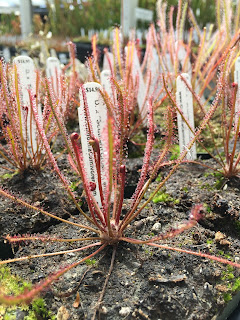In the
Savage Garden (Revised Version), on page 173-4, I discuss the fascinating and mysterious sundew hybrid
Drosera x hybrida. This is a natural cross that has been found a few times in the New Jersey Pine Barrens between
D. intermedia and
D. filiformis var.
filiformis. It
is a beautiful small sundew, reddish in color, usually about three to
four inches high, with thread-like leaves that get a little broader
towards their ends and stand upright. The flowers are of the palest
pink and being a typical sundew hybrid, it is sterile. We have several
of them growing in our outdoor bog at California Carnivores and they
remind me of my youth growing up on the "Joisey Shore" not far from one
location where they once grew, Lake Absegami.
 |
| Drosera x hybrida 'Butterfly Valley' |
I also discuss in my book the bizarre mutated plant, known as
D. x hybrida 'Butterfly Valley'. Some original specimens of
D. x hybrida were introduced to this valley in the Sierra mountains of California, where
D. rotundifolia is present, and many cobra plants,
Darlingtonia californica. Strangely,
these plants underwent a mutation, possible due to frost while the
plants were in flower, and apparently became fertile, producing
occasional seed. You can see my discussion of this discovery in my
book. We have finally produced a number of these plants by leaf
cuttings, not seed. Many of these plants are mature and sending up
flower stalks. Our original specimen of this Butterfly Valley clone was
in the greenhouse, and the one time I checked for seed, there was
none. It's possible it does not self-pollinate, and may need insect
pollinators or wind to set seed. We shall see. They are going on sale
now, and I'd like to know if any of our customers have luck with seed
production. They are beautiful none-the-less, and easily propagate from
leaf cuttings. Being temperate to cold-temperate, I recommend them for
outdoors where winters are lightly to very frosty. One interesting
possibility is that seed grow offspring may take a bit more after one
parent or the other, so variety in the leaf shape may vary.
A very exciting thing for California Carnivores is the new thread-leaf
hybrid we will shortly be releasing (some are ready now with more to
come). The co-founder of the Carnivorous Plant Newsletter, Joe
Mazrimas, gave us a sample plant a couple of years ago, and I absolutely
love it!!! It is an artificial cross between
D. anglica and the thread-leaved sundew known as both
D. filiformis var. tracyi or D. tracyi, which is native to the Florida pan-handle.
D. anglica, sometimes
known as the English sundew, not only grows in the British Isles but
also throughout the northern hemisphere in North America, being a
primarily high latitude plant. It has elongated spoon-to-paddle shaped
leaves, and is a green plant with red tentacles.
D. tracyi has long filiform leaves that are nearly pure green.
 |
| Drosera anglica |
 |
| Drosera filiformia var. tracyi |
Weirdly, and this often happens with hybrids, the cross of
D. anglica x tracyi is
a dark red plant, with long thin leaves to about five to six inches.
And the leaves have the ability of movement, mostly near the ends, where
they can fold up around hapless prey! Being a cross between a very
cold-temperate sundew and a warm-temperate one, it's cold hardiness will
need to be explored. It may survive happily in climates with very cold
winters, as well as milder ones
 |
| small Drosera anglica x tracyi |
It was Steve Clemesha,
a very long time grower of carnivorous plants in Australia, who made
this cross in 2008 and sent Joe a sample. Steve had tried in vane to
grow the elusive and difficult
D. linearis, without success
(like me!) since this Great Lakes species prefers mainly alkaline bogs
with very frigid winters. He experimented, wanting to produce a plant
with a similar look to
D. linearis (which actually looks most similar to a small
D. capensis 'narrow
leaf' than anything else). The best clone he chose is the one we will
be offering for sale. It has not yet been registered by Steve or Joe,
but Joe suggested the name
Drosera x 'Southern Cross' due to the location down under where this hybrid was made.



